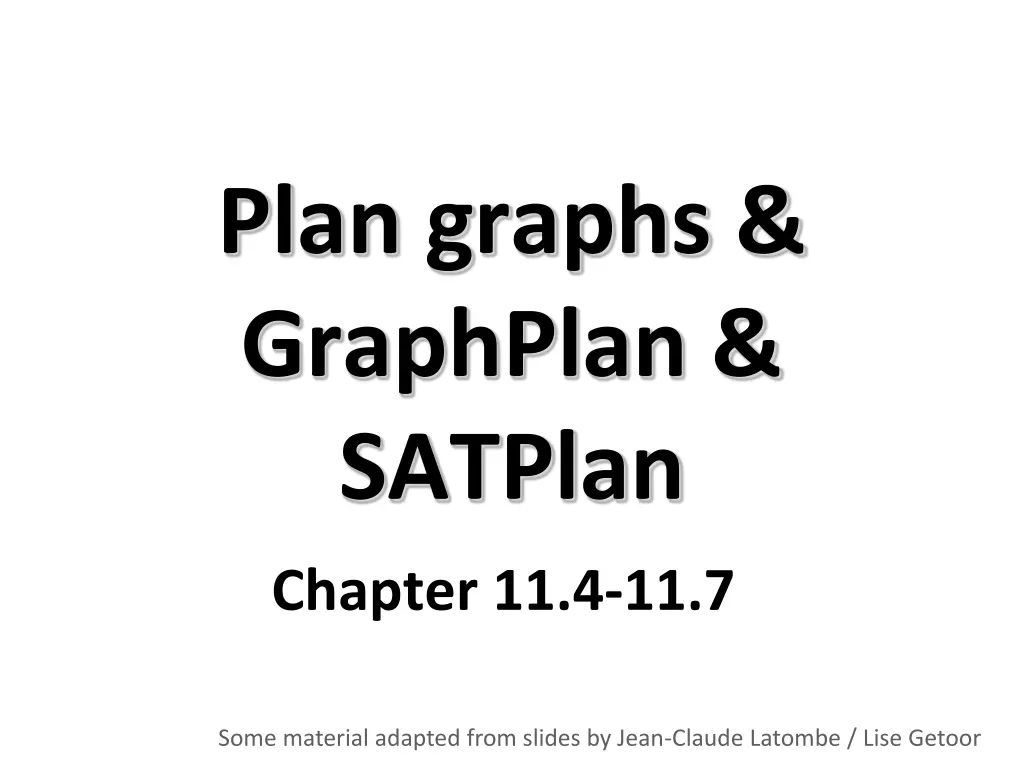
Planning Graphs and GraphPlan Overview
Learn about the fundamentals of Planning Graphs and GraphPlan, including the basic idea, construction of planning graphs, properties of GraphPlan, and examples like having your cake and eating it too. Dive into how GraphPlan encodes constraints on possible plans and constrains the search for valid plans efficiently. Discover the structure of planning graphs with alternating layers for propositions and actions, and how GraphPlan operates to find shortest plans effectively.
Download Presentation

Please find below an Image/Link to download the presentation.
The content on the website is provided AS IS for your information and personal use only. It may not be sold, licensed, or shared on other websites without obtaining consent from the author. If you encounter any issues during the download, it is possible that the publisher has removed the file from their server.
You are allowed to download the files provided on this website for personal or commercial use, subject to the condition that they are used lawfully. All files are the property of their respective owners.
The content on the website is provided AS IS for your information and personal use only. It may not be sold, licensed, or shared on other websites without obtaining consent from the author.
E N D
Presentation Transcript
Plan graphs & GraphPlan & SATPlan Chapter 11.4-11.7 Some material adapted from slides by Jean-Claude Latombe / Lise Getoor
GraphPlan: Basic idea Construct a planning graph that encodes constraints on possible plans Use graph to constrain search for a valid plan Planning graph can be built for each problem in a relatively short time Extract a solution from planning graph
Planning graph Directed, leveled graph with alternating layers of nodes Odd layers (state levels) represent candidate propositions that could possibly hold at step i Even layers (action levels) represent candidate actions that could possibly be executed at step i, including maintenance actions [do nothing] Arcs represent preconditions, adds and deletes Can only execute one real action at a step, but the data structure keeps track of all actions & states that are possible
GraphPlan properties STRIPS operators: conjunctive preconditions, no conditional or universal effects, no negations Planning problem must be convertible to propositional representation NO continuous variables, temporal constraints, Problem size grows exponentially Finds shortest plans (by some definition) Sound, complete, and will terminate with failure if there is no plan
Having your cake & eating it too Init(Have(Cake) Eaten(Cake) ) Goal(Have(Cake) Eaten(Cake)) Action(Eat(Cake) PRECOND: Have(Cake) EFFECT: Have(Cake) Eaten(Cake)) Action(Bake(Cake) PRECOND: Have(Cake) EFFECT: Have(Cake)
What actions and what literals? Add an action in level Ai if all of its preconditions are present in level Si Add a literal in level Si if it is the effect of some action in level Ai-1(including no-ops) Level S0 has all of the literals from initial state
Planning Graph for Cake Example Level S0 has all literals from initial state
Planning Graph for Cake Example Level S0 has all literals from initial state Level A0 has all actions whose preconditions are satisfied in S0 , including no-ops
Planning Graph for Cake Example Level S0 has all literals from initial state Level A0 has all actions whose preconditions are satisfied in S0 , including no-ops Actions connect preconditions to effects Gray arcs connect propositions that are mutex (mutually exclusive) & actions that are mutex
Mutex Arcs Mutex arc between two actions indicates that it is impossible to perform the actions in parallel Mutex arc between two literals indicates that it is impossible to have these both true at this stage
Computing mutexes Mutex actions Inconsistent effects: two actions that lead to inconsistent effects Interference: an effect of first action negates precondition of other action Competing needs: a precondition of first action is mutex with a precondition of second action Mutex literals one literal is negation of the other one Inconsistency support: each pair of actions achieving the two literals are mutually exclusive
Planning Graph for Cake Example Actions connect preconditions to effects Gray arcs connect propositions that are mutex Actions at level Ai must have support from a set of literals in state Si that have no mutex relations among themselves
Planning Graph for Cake Example Actions at level Ai must have support from a set of literals in state Si that have no mutex relations among themselves Stop when the set of literals does has not changed
Planning Graph for Cake Example If all of the literals in the goal are in the final state and are non-mutex We can try to extract a plan from the plan graph
GraphPlan function GRAPHPLAN(problem) returns solution or failure graph INITIAL-PLANNING-GRAPH(problem) goals CONJUNCTS(problem.GOAL) nogoods an empty hash table fort = 0 to do if goals all non-mutex in Stof graph then solution EXTRACT-SOLUTION(graph, goals, NUMLEVELS(graph), nogoods) ifgraph and nogoods have both leveled off then return failure graph EXPAND-GRAPH(graph, problem) From Fig. 10.9, p. 383
Spare Tire Problem Init(Tire(Flat) Tire(Spare) At(Flat,Axle) At(Spare,Trunk)) Goal(At(Spare,Axle)) Action(Remove(obj,loc), PRECOND: At(obj,loc), EFFECT: At(obj,loc) At(obj,Ground)) Action(PutOn(t, Axle), PRECOND: Tire(t) At(t,Ground) At(Flat,Axle), EFFECT: At(t,Ground) At(t,Axle)) Action(LeaveOvernight, PRECOND: , EFFECT: At(Spare,Ground) At(Spare,Axle) At(Spare,Trunk) At(Flat,Ground) At(Flat,Axle) At(Flat,Trunk)) From Fig. 10.2, p. 370
Spare Tire Planning Graph From Fig. 10.10, p. 384
Planning graph for heuristic search Using the planning graph to estimate the number of actions to reach a goal If a literal does not appear in the final level of the planning graph, then there is no plan that achieve this literal! h =
Heuristics max-level: take the maximum level where any literal of the goal first appears admissible level-sum: take the sum of the levels where any literal of the goal first appears not admissible, but generally efficient (specially for independent subplans) set-level: take the minimum level where all the literals of the goal appear and are free of mutex admissible
BlackBox Planner STRIPS-based plan representation Planning graph CNF representation CSP/SAT solver CSP solution Plan

